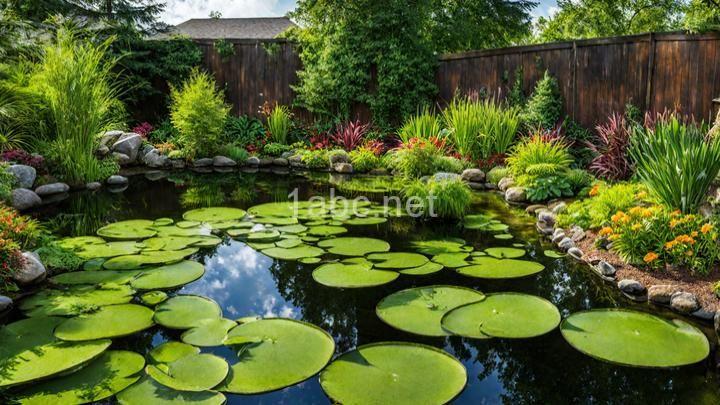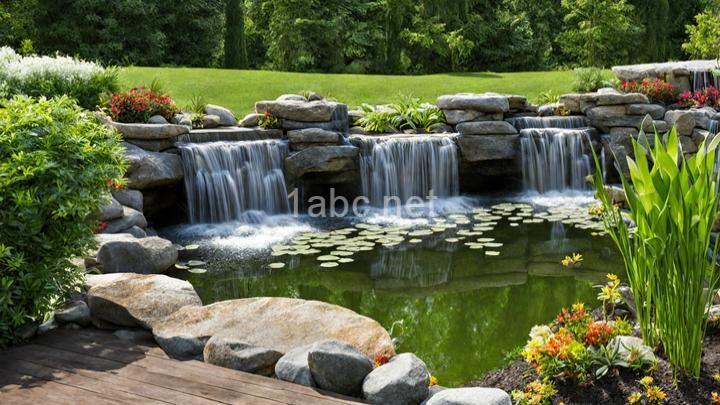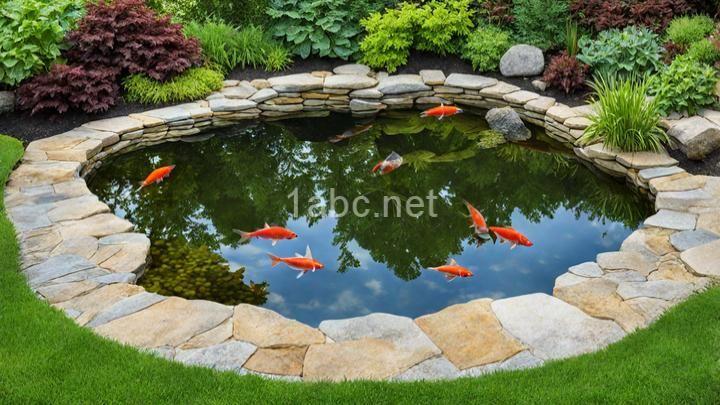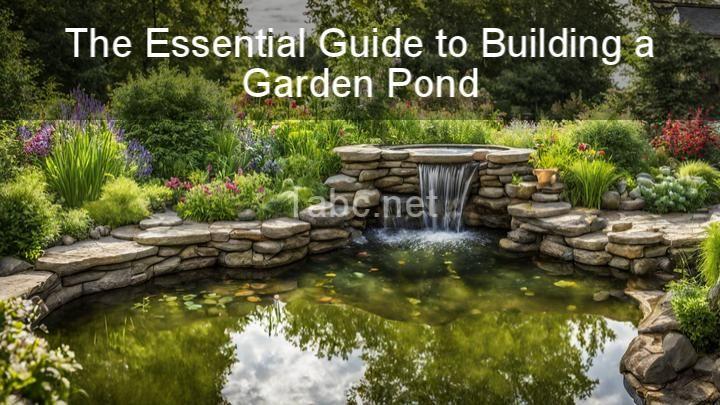Creating Balance: How Water Plants Improve the Health of Your Garden Pond

Introduction:
Imagine stepping into your backyard oasis, the sun shining down on your beautiful garden pond. The water sparkles in the light, and you can hear the gentle sound of a waterfall in the distance. But what if I told you that there's something missing from this picturesque scene? That missing piece is water plants. They play a crucial role in maintaining the health and balance of your garden pond. In this blog post, we'll explore the importance of water plants and how they contribute to the overall well-being of your pond. So grab a cup of tea, sit back, and let's dive into the world of water plants!
Section 1: The Importance of Water Plants
One might wonder, why are water plants so important in a garden pond? Well, the answer lies in their ability to create a harmonious ecosystem. Water plants contribute to oxygenation, filtration, and nutrient absorption, all of which are crucial for a healthy pond.
When it comes to oxygenation, water plants are the unsung heroes. They help in oxygenating the water, creating a healthier environment for fish and other aquatic organisms. Submerged plants, such as hornwort and anacharis, play a vital role in this process. Through photosynthesis, they produce oxygen, which is essential for the survival of underwater life.
Section 2: Oxygenation and Aeration
Imagine taking a deep breath of fresh air after a long day. That feeling of rejuvenation is what water plants provide to your garden pond. By oxygenating the water, they create an environment that supports the livelihood of fish and other aquatic organisms. This not only ensures their survival but also enhances the overall health of your pond.
Submerged plants, like the popular hornwort and anacharis, are masters of oxygen production. Through photosynthesis, they absorb carbon dioxide and release oxygen, providing a constant supply of fresh air for your underwater friends. This oxygenation process is essential for fish respiration and eliminates the risk of oxygen depletion in your pond.
Another benefit of a well-oxygenated pond is the reduction of algae growth and improved water clarity. Algae thrive in environments lacking oxygen, and their overgrowth can turn your beautiful pond into a green mess. By introducing water plants, you're not only providing oxygen but also creating an environment where algae struggle to survive. This leads to clearer water, allowing you to enjoy the beauty of your pond without the hassle of excessive algae maintenance.
Section 3: Natural Filtration
In addition to oxygenation, water plants act as natural filters, removing excess nutrients and chemicals from the pond. This filtration process plays a crucial role in maintaining water quality and clarity.
Floating plants, such as water lilies and water lettuce, provide shade that helps prevent excessive algae growth. By covering the surface of the water, they limit the amount of sunlight reaching the depths of your pond, where algae thrive. The shade created by these floating plants acts as a natural sunscreen for your pond, keeping it cool and unattractive to algae.
Moreover, submerged and marginal plants contribute to natural filtration by absorbing nutrients and chemicals. They act as sponges, soaking up excess nitrates and phosphates that can otherwise cause imbalances in pond ecosystems. This nutrient absorption not only keeps your pond healthy but also prevents the growth of unwanted plants and algae.
Section 4: Nutrient Absorption
Speaking of nutrient absorption, it's important to choose water plant species that are well-suited for your pond's individual needs. Different plants have varying abilities to uptake and process nutrients, so it's crucial to select the right ones for a balanced ecosystem.
Certain water plant species, such as duckweed and water hyacinth, are known for their exceptional nutrient-absorbing capabilities. These plants act as natural purifiers, removing excess nutrients that can lead to imbalances in your pond. By incorporating these plants into your pond design, you're creating a self-sustaining system that requires minimal intervention.
Section 5: Adding Beauty and Visual Appeal
Beyond their functional benefits, water plants also add beauty and visual appeal to your garden pond. They enhance the aesthetic value of your backyard oasis, turning it into a vibrant and captivating space.
Imagine the graceful blooms of water lilies, their vibrant colors reflecting on the serene surface of your pond. Picture the tall and slender stalks of cattails, gently swaying in the breeze. These are just a few examples of the diverse range of aquatic plants that can add texture, color, and height to your pondscape.
Whether you prefer the delicate beauty of floating plants or the architectural elegance of emergent plants, there's a water plant out there to suit your taste. By incorporating different types of aquatic plants, you can create a visually stunning pond that becomes the centerpiece of your garden.
Conclusion:
Water plants are not just decorative elements; they are essential for maintaining a healthy and balanced garden pond. From oxygenation and natural filtration to nutrient absorption and visual appeal, these plants play a crucial role in creating a harmonious ecosystem.
So, if you're considering adding a garden pond to your backyard or looking to improve the health of your existing pond, don't forget about water plants. They are the secret to creating balance and ensuring the longevity of your aquatic paradise.
Remember, a healthy pond is a happy pond! So dive into the world of water plants, explore the diverse species available, and watch your garden pond thrive. If you need further assistance or want to learn more about water plants, don't hesitate to reach out. Happy ponding!
FREQUENTLY ASKED QUESTIONS
What are water plants and why are they important for my garden pond?
Water plants, also known as aquatic plants, are plants that grow in water or in soil that is permanently saturated with water. These plants are crucial for maintaining a healthy and balanced ecosystem in your garden pond. There are several reasons why water plants are important for your garden pond. Firstly, they provide oxygen to the water through a process called photosynthesis. This is essential for the survival of fish and other aquatic organisms in your pond. Additionally, water plants help to filter the water by absorbing excess nutrients, such as nitrogen and phosphorus, which can cause algae blooms and water pollution.
Water plants also provide shelter and hiding places for fish, frogs, and other small creatures in your pond. They offer shade, reducing water temperature and preventing the growth of certain harmful bacteria. Moreover, water plants help to stabilize the pond's ecosystem by preventing soil erosion and reducing the growth of unwanted aquatic weeds.
When choosing water plants for your garden pond, consider a mix of submerged, floating, and emergent plants. Submerged plants, such as Anacharis or Hornwort, provide oxygen and absorb nutrients from the water. Floating plants, like Water Lettuce or Water Hyacinth, help to shade the water and reduce algae growth. Emergent plants, such as Water Lilies or Cattails, add beauty to your pond while providing habitat and shelter for wildlife.
In conclusion, water plants play a crucial role in maintaining a healthy and thriving garden pond. They enhance the aesthetics of your pond, provide oxygen, filter the water, offer shelter to aquatic creatures, and contribute to the overall balance of the ecosystem. So, don't forget to include water plants in your pond to enjoy the benefits they bring.
How do water plants improve the health of my garden pond?
Water plants play a crucial role in improving the health of your garden pond. They provide numerous benefits that contribute to the overall well-being of the pond ecosystem.Firstly, water plants act as natural filters by absorbing excess nutrients from the water. This process, known as nutrient uptake, helps prevent the growth of algae and other unwanted organisms that can harm the pond's balance. By reducing nutrient levels, water plants promote clearer water and create a more aesthetically pleasing environment.
Additionally, water plants enhance oxygenation in the pond. Through a process called photosynthesis, they release oxygen into the water during daylight hours. This increased oxygenation benefits the fish and other aquatic life in the pond by improving their respiration and overall health.
Moreover, water plants provide shelter and protection for various organisms in the pond. Their foliage and root systems offer hiding places for fish, tadpoles, and other small aquatic creatures, providing them with a safe haven from predators. This promotes biodiversity and creates a balanced ecosystem within the pond.
Water plants also help to stabilize the pond's water temperature. Their foliage provides shade, reducing excessive sunlight exposure and preventing rapid temperature fluctuations. This is particularly beneficial during hot summer days, as it helps maintain a more stable and favorable environment for the pond inhabitants.
Lastly, water plants contribute to the aesthetic appeal of your garden pond. With their vibrant colors and graceful forms, they add beauty and visual interest to the overall landscape. Whether you prefer blooming flowers or delicate floating leaves, water plants can create a serene and captivating atmosphere in your garden pond.
In summary, water plants are essential for maintaining a healthy garden pond. They act as natural filters, improve oxygenation, provide shelter, stabilize water temperature, and enhance the overall beauty of your pond. By incorporating a variety of water plants into your pond, you can create a thriving ecosystem that brings joy and tranquility to your outdoor space.
What types of water plants can I add to my garden pond?
There are several types of water plants that you can add to your garden pond to enhance its beauty and create a more natural environment. Some popular options include:
-
Water Lilies: These stunning plants have vibrant flowers that float on the water's surface. They come in a variety of colors and can add a touch of elegance to your pond.
-
Lotus: Known for their large, showy flowers, lotus plants are a popular choice for garden ponds. They require ample space as they can spread out and create a stunning focal point.
-
Water Hyacinth: With their floating leaves and delicate lavender flowers, water hyacinths are not only visually appealing but also help to control the growth of algae in your pond.
-
Water Iris: These plants add a splash of color with their vibrant blooms. They can grow both in shallow water at the edge of the pond or in deeper areas.
-
Water Hawthorn: This unique plant blooms in winter or early spring, adding a touch of beauty to your pond during colder months. It has small white flowers that float on the water's surface.
-
Taro: Taro is a versatile water plant that can be grown in both shallow and deeper areas of your pond. It has large, heart-shaped leaves that add a tropical feel to your garden.
Remember to consider the size of your pond and its location when choosing water plants. Some plants may require more sunlight or specific conditions to thrive. Additionally, it's important to regularly maintain your pond to ensure the health and growth of the plants.
How do I plant water plants in my garden pond?
To plant water plants in your garden pond, follow these simple steps:
-
Choose the right plants: Select water plants that are suitable for your climate and pond size. Consider plants like water lilies, lotus, water hyacinth, and water lettuce.
-
Prepare the planting containers: Use special aquatic plant containers or baskets with holes to allow water circulation. Fill them with a mix of aquatic soil and gravel.
-
Position the containers: Place the containers in the desired locations around your pond, ensuring they are at the appropriate depths. Consult the specific requirements for each plant, as some may need deeper water than others.
-
Plant the water plants: Gently remove the plants from their pots and tease the roots apart. Place the plants in the containers, making sure the roots are covered with soil. Add more soil as needed to secure the plants in place.
-
Adjust water levels: Fill the pond with water, gradually adjusting the levels to the recommended depths for the different water plants. This will ensure proper growth and development.
-
Maintain the plants: Regularly check the water levels and adjust as needed. Trim any dead or decaying leaves to promote healthy growth. Fertilize the plants according to their specific needs, but be mindful not to over-fertilize, as it can lead to algae problems.
-
Monitor and care for your plants: Keep an eye on your water plants for any signs of pests or diseases. Remove any unwanted growth or debris from the pond to maintain a clean and healthy environment for your plants.
Remember, each water plant may have its own care requirements, so it's essential to research and understand the needs of the specific plants you choose. Enjoy watching your garden pond come to life with the beauty of water plants!


